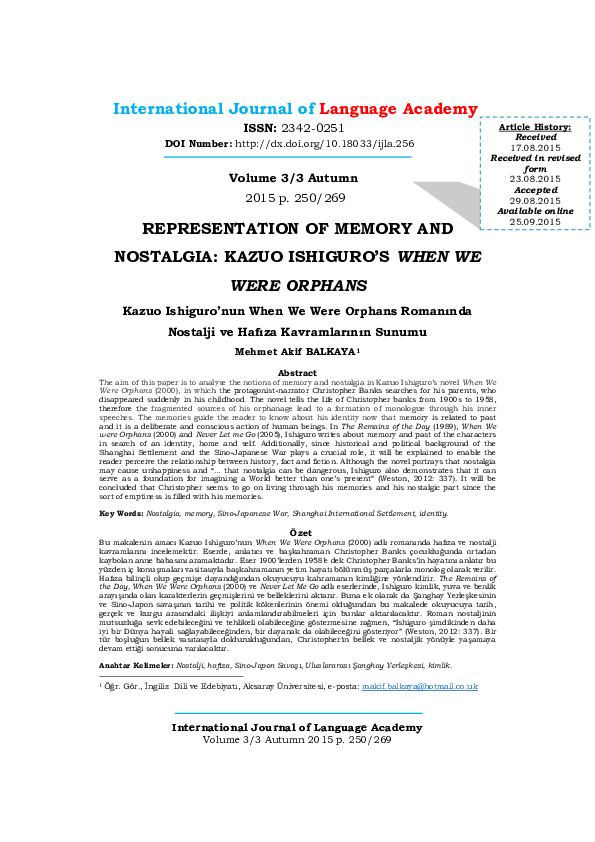Memory, Forgetting, And Identity In The Works Of Kazuo Ishiguro

Table of Contents
The Unreliable Narrator and the Distortion of Memory
Ishiguro frequently employs unreliable narrators whose memories are fragmented, incomplete, or deliberately suppressed. This technique underscores the subjective and often distorted nature of Kazuo Ishiguro memory, forcing the reader to actively participate in reconstructing the truth. The inherent unreliability of the narrative voice creates a compelling tension, leaving the reader to question the veracity of the events presented.
-
Never Let Me Go: Kathy, the narrator, possesses hazy recollections of her childhood at Hailsham, gradually unveiling the clones' tragic fate. Her narrative unfolds piecemeal, mirroring the fragmented memories of the clones themselves, contributing to the overall sense of unease and uncertainty surrounding their lives and identities. The incomplete nature of her unreliable memory enhances the novel's emotional impact.
-
The Remains of the Day: Stevens, a butler, meticulously details his service, yet his account is significantly shaped by his repressed emotions and selective memory. His rigid adherence to duty and his avoidance of confronting difficult feelings result in a distorted and incomplete view of his past. This memory distortion showcases the psychological impact of selective memory and its role in self-deception, highlighting a profound disconnect between his idealized self-image and the reality of his experiences.
The use of unreliable narration in Ishiguro's novels significantly challenges the reader. We are forced to piece together the narrative alongside the character, actively engaging with the fragmented memories and piecing together the reality from a purposefully obfuscated perspective. This constant questioning of the truth becomes integral to understanding the characters’ psychological journeys and their struggle to reconcile their past with their present. The Kazuo Ishiguro unreliable narrator is not simply a narrative device; it’s a powerful exploration of the human capacity for self-deception.
Memory as a Tool for Self-Discovery and Identity Formation
Ishiguro’s characters grapple with fragmented memories to piece together their identities and pasts. Memory, even when flawed and incomplete, becomes a crucial tool for self-understanding, a painstaking process of reconstruction and reconciliation. The act of remembering, therefore, actively shapes and reshapes personal identity.
-
When We Were Orphans: Christopher Banks' search for his lost parents is a journey into the labyrinthine corridors of his own fragmented identity. The blurred lines between reality and memory constantly challenge the reader's perception of truth, as his quest for his past unveils as much about his present self as it does about his parents.
-
A Pale View of Hills: Etsuko’s memory reconstruction of her daughter's life and death profoundly impacts her identity in the present. Her fragmented recollections, filled with gaps and ambiguities, reflect the unresolved grief and the lasting emotional scars that define her present self.
This continuous struggle to connect the past to the present underlies the characters' quest for identity. The process of sifting through fragmented memories becomes inextricably linked with their self-discovery. The notion of a stable, singular identity is challenged; instead, identity emerges as a fluid and evolving entity, continuously shaped and reshaped by the process of remembering. The relationship between Kazuo Ishiguro identity and memory becomes one of mutual constitution – memory creating identity, and identity influencing the way memories are recalled and interpreted.
Forgetting as a Coping Mechanism and a Form of Self-Preservation
Ishiguro’s novels often depict forgetting as a complex coping mechanism, a strategy for managing trauma, loss, or difficult truths. This intentional act of forgetting is not simply a passive lapse of memory but an active choice with profound ethical and psychological implications.
-
The Remains of the Day: Stevens' suppression of emotion and idealized view of the past exemplify how memory suppression serves as a form of self-preservation. His rigid adherence to an idealized image of his past prevents him from confronting the reality of his personal failures and the injustices he witnessed.
-
Never Let Me Go: The clones’ limited understanding of their existence and their deliberate avoidance of certain truths reflects a form of collective forgetting, a societal memory suppression enforced to maintain the status quo. This shared ignorance becomes a coping mechanism, allowing them to navigate an existence defined by profound loss and the inherent injustice of their situation.
The ethical implications of choosing to forget are central to Ishiguro's exploration of Kazuo Ishiguro forgetting. His characters grapple with the consequences of suppressing painful truths, showing how this suppression impacts their moral choices and relationships with others. The narratives demonstrate how forgetting, while potentially providing temporary solace, can ultimately hinder personal growth and genuine understanding.
The Role of Nostalgia and the Past in Shaping the Present
Ishiguro masterfully utilizes nostalgia and the idealized past to create a stark contrast with the harsh realities of the present. This juxtaposition reveals the limitations of romanticizing the past and the importance of confronting difficult truths. The characters often find themselves trapped by their idealized memories, hindering their ability to navigate the present effectively.
-
Across Ishiguro's novels, the romanticized past frequently serves as a refuge from the complexities and disappointments of the present. This idealized vision, however, prevents the characters from engaging fully with the present and from accepting the difficult aspects of their experiences.
-
The interplay between Kazuo Ishiguro nostalgia and the present highlights the potential dangers of clinging to idealized memories. By confronting their pasts, even the difficult parts, Ishiguro’s characters demonstrate the potential for healing and growth. The past continues to shape the present; however, true progress necessitates an honest engagement with its complexities.
The past and present are not presented as mutually exclusive entities but as inextricably intertwined aspects of a single narrative. This nuanced portrayal of memory encourages readers to critically examine their own relationship with their pasts and their influence on the present.
Conclusion
Kazuo Ishiguro masterfully uses the interplay of memory and forgetting to explore profound questions about identity, self-deception, and the human condition. His unreliable narrators and fragmented narratives challenge readers to grapple with the complexities of the past and its influence on the present. The intricate relationship between Kazuo Ishiguro memory, forgetting, and identity underscores the fragility of self and the ongoing struggle to construct a coherent and meaningful understanding of who we are.
Further explore the intricate relationship between Kazuo Ishiguro memory, forgetting, and identity by delving into his complete body of work. You’ll discover compelling narratives that examine the fragility of self and the enduring power of remembrance. Consider researching his novels further to gain a deeper understanding of this fascinating theme and the lasting impact of memory on the human experience.

Featured Posts
-
 Massive Rubber Duck Installation In Myrtle Beach The Story Behind The Visit
May 25, 2025
Massive Rubber Duck Installation In Myrtle Beach The Story Behind The Visit
May 25, 2025 -
 Russell And The Typhoons Discography Tours And Notable Performances
May 25, 2025
Russell And The Typhoons Discography Tours And Notable Performances
May 25, 2025 -
 Roc Agel La Finca De Los Grimaldi Donde Se Refugio Charlene
May 25, 2025
Roc Agel La Finca De Los Grimaldi Donde Se Refugio Charlene
May 25, 2025 -
 Annie Kilners Solo Outing After Kyle Walkers Night With Two Women
May 25, 2025
Annie Kilners Solo Outing After Kyle Walkers Night With Two Women
May 25, 2025 -
 Wedbushs Apple Outlook Bullish Despite Price Target Reduction
May 25, 2025
Wedbushs Apple Outlook Bullish Despite Price Target Reduction
May 25, 2025
Latest Posts
-
 Tzahrat Tl Abyb Mtalb Bitlaq Srah Alasra
May 26, 2025
Tzahrat Tl Abyb Mtalb Bitlaq Srah Alasra
May 26, 2025 -
 Ahtjajat Mtwaslt Fy Tl Abyb Ttalb Balifraj En Alasra
May 26, 2025
Ahtjajat Mtwaslt Fy Tl Abyb Ttalb Balifraj En Alasra
May 26, 2025 -
 Astmrar Almzahrat Fy Tl Abyb Llmtalbt Bieadt Alasra
May 26, 2025
Astmrar Almzahrat Fy Tl Abyb Llmtalbt Bieadt Alasra
May 26, 2025 -
 Mzahrat Hashdt Btl Abyb Llmtalbt Bewdt Alasra
May 26, 2025
Mzahrat Hashdt Btl Abyb Llmtalbt Bewdt Alasra
May 26, 2025 -
 Tzahrat Mstmrt Fy Tl Abyb Llmtalbt Bitlaq Srah Alasra
May 26, 2025
Tzahrat Mstmrt Fy Tl Abyb Llmtalbt Bitlaq Srah Alasra
May 26, 2025
